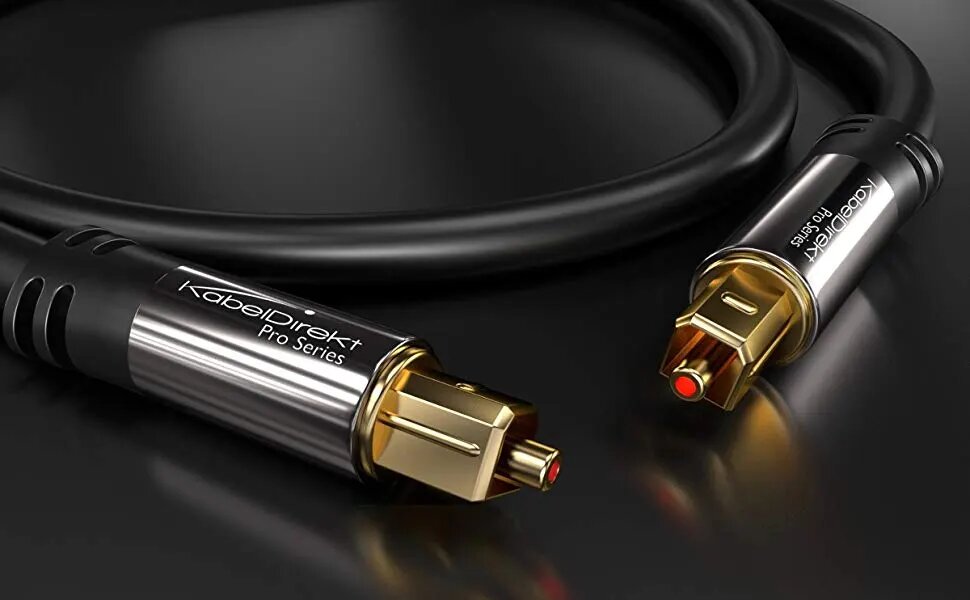Optical To Optical Audio Cable – The Ultimate Guide To Superior Sound Quality!
When it comes to setting up the perfect home audio system, the type of cables you choose can make a world of difference. One of the most important types of cables to consider is the optical to optical audio cable. If you’re looking for an audio connection that provides pristine sound quality without the interference or signal degradation often found in traditional copper cables, this guide is for you.
An optical to optical audio cable is a high-quality connection that transmits audio signals digitally between devices, using light pulses for clear, interference-free sound. It is frequently used to link gaming consoles, TVs, and audio systems.
In this article, we will explore everything you need to know about optical to optical audio cables, from what they are, why they are superior, to how to choose the right one for your needs.
What is an Optical to Optical Audio Cable?
An optical to optical audio cable is a special type of digital cable that sends audio signals using light instead of electrical signals. It works by using fiber optics, which are tiny strands made from glass or plastic that carry the audio signals in the form of light. This method helps avoid problems like electrical interference, making it perfect for high-quality audio systems. Since the light signals travel through the fiber optic strands, they can maintain the full clarity and quality of the audio without any loss or distortion. This makes optical cables a popular choice for people who want to enjoy clear, high-fidelity sound in their audio setups.

The way an optical to optical audio cable functions is fairly simple. The audio signal is first changed into light, which then moves through the cable’s fiber optic fibers. These fibers act like small highways for the light signals, keeping them safe from outside interference. Once the light reaches the other end of the cable, it is turned back into audio that can be played through speakers or headphones. This process ensures that the audio signal stays clear and precise, providing a smooth and reliable connection. By using light instead of electrical signals, optical cables are able to deliver faster, more accurate, and high-quality audio transfer.
Why Choose Optical to Optical Audio Cables?
1. Advantages Over Other Types of Cables:
There are many types of audio cables, but optical to optical audio cables are preferred for certain reasons. One of the key benefits is that optical cables are immune to electromagnetic interference (EMI), which can affect the sound quality of traditional copper cables. Additionally, optical cables offer superior clarity and detail, making them an excellent choice for audiophiles or anyone who values top-tier sound quality.
2. Superior Sound Quality:
The main advantage of optical to optical audio cables lies in the sound quality. These cables transmit audio signals with a higher fidelity than traditional analog cables, ensuring the sound is clear, crisp, and distortion-free. Whether you’re watching movies, gaming, or listening to music, the clarity of optical cables can enhance your audio experience significantly.
Key Features of Optical to Optical Audio Cables!
- Optical to optical audio cables are made for both durability and performance.
- They have tough outer layers that protect the delicate fibers inside.
- The outer layers are usually made from flexible PVC or rubber for added protection and easy installation.
- These cables come in a variety of lengths to suit different setups.
- You can find short cables for compact systems or long cables for larger room setups.
- High-quality optical cables are made from durable materials to protect the fibers from wear and tear.
- The connectors are often gold-plated to prevent corrosion and ensure a strong, long-lasting connection.
How Does Optical Audio Technology Work?
To fully understand why optical to optical audio cables are so effective, it’s important to grasp how optical audio technology works. Sound is converted into light pulses in an optical system, which then pass through the cable. Because light is not susceptible to electromagnetic interference, this ensures a stable, high-quality signal. Additionally, optical cables support high-definition audio formats like Dolby TrueHD and DTS-HD Master Audio, which are often required for advanced home theater systems.
Read: Tissariss – A Timeless Craft of Tradition and Innovation!
Applications of Optical to Optical Audio Cables!
1. Home Audio Systems:
Optical to optical audio cables are perfect for home audio systems, where they are commonly used to connect various devices, including soundbars, AV receivers, and other audio equipment. Their ability to transmit clear, high-quality sound over long distances makes them ideal for home theater setups.
2. Gaming Consoles and Systems:
For gaming enthusiasts, optical to optical audio cables can enhance the gaming experience by delivering clear, immersive audio. The cables are commonly used to connect gaming consoles like PlayStation or Xbox to sound systems, providing high-quality audio for gaming sessions.
3. Television and Audio Equipment:
Modern televisions and audio equipment are often equipped with optical ports for high-quality audio output. By using an optical to optical audio cable, you can ensure the audio from your TV is transmitted without any degradation in quality.
Comparison of Optical to Optical Audio Cable vs Other Audio Cables!
| Feature | Optical to Optical Audio Cable | HDMI ARC | RCA Analog Cables | AUX (3.5mm Jack) |
| Audio Quality | Excellent (Digital) | Excellent (Digital + Video) | Moderate (Analog) | Good (Analog) |
| Signal Type | Digital (Light-based) | Digital (Electrical) | Analog (Electrical) | Analog (Electrical) |
| Interference Resistance | High | Moderate to High | Low | Low |
| Support for Surround Sound | Yes (Up to 5.1) | Yes (Up to 7.1) | No | No |
| Video Transmission | No | Yes | No | No |
| Common Uses | TVs, soundbars, game consoles | TVs, home theaters | Older stereo systems | Phones, PCs, small speakers |
| Cost | Moderate | High | Low | Low |
| Cable Length Efficiency | Good for long distances | Good | Poor (signal loss) | Fair |
How to Maintain Optical to Optical Audio Cables?
To make sure your optical to optical audio cables last a long time, it’s important to handle them with care. Try not to bend the cables too much or twist them sharply, as this can damage the inside parts that carry the signal. When you’re not using the cables, store them properly instead of leaving them lying around. Rolling them up gently and placing them in a dry, clean place can help keep them in good shape. Keeping your cables in a safe spot also protects them from getting stepped on, crushed, or tangled with other cords, which can lead to wear and tear over time.
It’s also a good idea to keep the connectors on your optical to optical audio cables clean. Dust or dirt on the tips can affect the sound quality, so gently wipe them with a soft microfiber cloth if needed. Avoid using harsh chemicals or water when cleaning. When storing the cables, choose a place that is not too hot or cold and doesn’t have a lot of moisture in the air. Extreme temperatures and high humidity can damage the cables over time. By keeping your cables clean and stored in a safe, dry place, you’ll help them stay in good working condition for years.
Comparison with Other Audio Cable Types!
1. Optical to HDMI Audio Cables:
Digital signals are sent using optical to optical and optical to HDMI cables, although optical cables are only used for audio, whereas HDMI cables can carry both audio and video.
2. HDMI vs. Optical Audio Cables: What’s Better?
While HDMI cables can transmit high-definition video and audio, optical to optical audio cables are often preferred for audio-only setups, providing a more dedicated connection with better sound quality.
How to Set Up Optical to Optical Audio Cables?
Setting up an optical to optical audio cable is easy. Follow these steps:
- Plug one end of the optical cable into the optical output port of your source device (e.g., TV or gaming console).
- Connect the other end of the cable to the optical input of your audio equipment (e.g., soundbar or AV receiver).
- Make sure both devices are powered on, and the optical audio output is selected in the device settings.
How Optical to Optical Audio Cables Enhance Sound Quality?
Optical to optical audio cables are a great choice because they send audio signals without the usual problems like interference or signal loss that can happen with other types of cables. Unlike traditional cables, which can pick up electrical interference and cause sound quality to drop, optical cables use light to carry the audio signals. This means there is no risk of sound distortion or loss of quality over distance, making the signal transfer clearer and more reliable. These cables are perfect for creating a high-quality sound experience, whether you’re setting up a home theater or just looking to improve your audio system.

Using optical to optical cables is an excellent way to get the best sound possible from your devices. The main advantage of these cables is their ability to deliver precise, high-quality audio with minimal risk of signal degradation. This makes them ideal for use in home audio setups, where you want every detail of the sound to come through clearly. Whether you’re listening to music, watching movies, or playing games, these cables help ensure that the audio you hear is as accurate and sharp as possible, giving you the best overall experience.
Optical to Optical Audio Cables vs. Other Digital Cables!
1. Comparison with Coaxial and RCA Cables:
While coaxial and RCA cables are commonly used for audio transmission, optical to optical audio cables offer a cleaner signal and are less prone to interference, making them a better choice for high-end audio setups.
2. Pros and Cons of Each:
Each type of cable has its advantages, but optical to optical audio cables are preferred for their superior sound quality and reliability.
Read: Tributeonprintedpics – A Comprehensive Guide!
FAQs:
1. What is the difference between optical to optical and HDMI cables?
Optical cables focus solely on transmitting high-quality audio, while HDMI cables transmit both audio and video signals.
2. Can optical audio cables improve sound quality?
Yes, optical audio cables transmit audio signals without degradation, providing clearer and more detailed sound.
3. Are optical audio cables compatible with all devices?
Optical audio cables are compatible with devices that have optical input/output ports, such as soundbars, gaming consoles, and TVs.
4. Why is my optical cable not working?
Check for damage, ensure proper connections, and verify that your devices are configured to output optical audio.
5. How do I choose the right length for my optical audio cable?
Measure the distance between your devices and choose a cable that allows for a secure connection without excess slack.
Conclusion:
Optical to optical audio cables are an excellent choice for those seeking high-quality, interference-free audio. Whether you’re setting up a home theater system, gaming console, or other audio equipment, these cables provide the clarity and detail you need to enjoy superior sound. By choosing the right optical to optical audio cable and taking care of it properly, you can ensure that your audio setup remains top-notch for years to come.
Also Read:
- Hoi-313 – A Journey Through Digital Romance And Ai Roleplay!
- Be1crypto – The Low-Fee Exchange Revolutionizing Cryptocurrency Trading!
- Bring Blorbo The Shrewd 25 Hobgoblin Hides – A Comprehensive Guide!
- Myfastbroker Loans Brokers – Trusted Loan Solutions!
- Features This Month – A Comprehensive Overview Of What’s New!



































































Post Comment